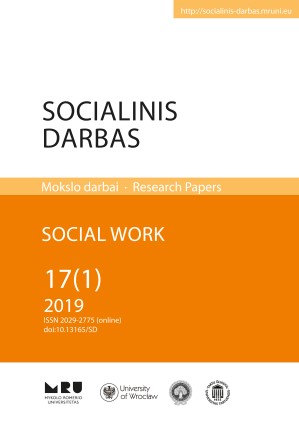VERBALINIO ELGESIO ANALIZĖS TAIKYMAS UGDANT
FUNKCIONALIĄ AUTIZMO SPEKTRO SUTRIKIMĄ TURINČIŲ
VAIKŲ KALBĄ
APPLICATION OF THE VERBAL BEHAVIOR ANALYSIS APPROACH IN DEVELOPING THE FUNCTIONAL LANGUAGE OF CHILDREN WITH AUTISM SPECTRUM DISORDERS
Author(s): Eglė Steponėnienė, Rita RaudeliūnaitėSubject(s): Education, Theoretical Linguistics, Applied Linguistics, Language acquisition, Psycholinguistics
Published by: Mykolas Romeris University
Keywords: autism spectrum disorders; verbal behavior analysis; verbal operants;
Summary/Abstract: According to the data from Lithuanian Institute of Hygiene, a number of autism spectrum disorders (ASD) has been increasing in Lithuania, e.g. from 833 cases in 2011 to 1423 cases in 2015. Language and social communication impairment is one of the main indicators of ASD, which makes the language development, social interaction, learning and teaching process of children with ASD complicated (Mody & Bellieveau, 2013; Arunachalam & Luyster 2016; and others). Traditional methodical approaches are usually ineffective in developing the language of children with ASD (Diržytė, Mikulėnaitė & Kalvaitis, 2016; Buivydaitė, Newman & Prasauskienė, 2017). The meta-analyses conducted by foreign researchers reveal (McPherson et al., 1984; Dymond et al. 2006; Sautter & LeBlanc, 2006; Petursdottir & Devine, 2017) that Skinner’s Verbal Behavior Analysis (1957) is one of the empirical evidence based effective approaches used to develop the language of children with ASD.The subject of the study: application of the verbal behavior analysis approach in developing the functional language of children with ASD.The aim of the study: to reveal the features of the verbal behavior analysis approach in developing the functional language of children with ASD in theoretical aspect.Data for the study was collected by performing a search of scientific sources related to the subject concerned and selecting the sources relevant to the aim of the study. Consequently, analysis, comparison, summary and aggregation of the selected sources were conducted.Foreign researchers have been conducting a number of studies on the possibilities of application of Skinner’s Verbal Behavior Analysis in developing the language of children with ASD. Verbal behavior is the type of behavior which is reinforced by conveying another person’s needs. This is a social interaction between the speaker and the listener, during which the speaker receives reinforcement and gains the environment control through the listener behaviour in particular. Determining the conditions and stimuli under control of which a certain verbal behaviour emerges is important. Empirical studies reveal that the verbal behaviour analysis is an efficient and scientifically based method for developing the language of children with ASD.B. F. Skinner (1957) distinguished six functional relations between controlling variables and verbal responses, and introduced the following new concepts: mand, tact, intraverbal, textual behavior, echoic and listener’s behavior. The above specific new terms were introduced by Skinner in order to clearly define a relation between a controlling stimulus, response and reinforcement. Based on verbal operant analysis, a correct definition of controlling stimuli enables development of functional social communication of children with ASD both in the verbal form of the language, and by employing any alternative communication means, such as gestures or symbols (e.g. PECS).The advantage of Skinner’s Verbal Behavior Analysis (1957) is that based on operant classification into primary and secondary ones, teachers may apply this approach both when teaching children with a delayed, impaired or non-existent language development, and when teaching children with an incorrect language development.
Journal: Socialinis darbas
- Issue Year: 17/2019
- Issue No: 1
- Page Range: 84-101
- Page Count: 18
- Language: Lithuanian

